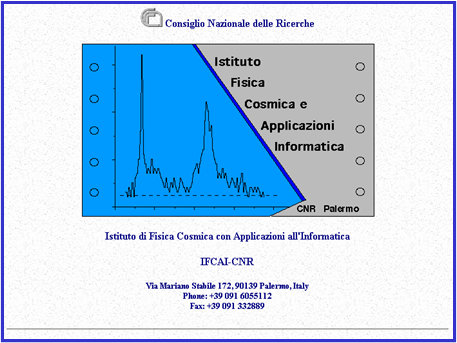
Study of isolated pulsars at IASF-Palermo has historical tradition. It started with the ESA mission COS-B that observed the sky above 30 MeV from 1975 to 1982 and was the main research field for the Institute. The first logo of this Institute was the Vela pulsar light curve observed with COS-B.
Another historical experiment, was the balloon borne French Italian gamma ray observatory FIGARO opportunely designed to study sources with a well defined temporal characteristic. It was working in the range 0.15-4 MeV and produced interesting results as the detection of a line at 440 keV in the Crab pulsed spectrum interpreted as annihilation line red shifted for gravitational effects and confirmed later using data from BATSE. The activity continued with BeppoSAX (see below) whose wide energy band allowed to model the Crab pulsed emission with the multicomponent model, and to define a curved model well suitable to describe high energy emission from young Crab-like pulsars.
Later on, researchers at IASF-Palermo were involved in the study of Gamma-ray emission from pulsars with AGILE and Fermi-GLAST satellites.
Read more about isolated pulsars.

X-ray astronomy has been one of the main activity of IASF-Palermo since its foundation with the participation to the European Spatial Agency (ESA) missions EXOSAT (launched in May 1983) and SpaceLab. Since 1980 to the end of the mission, IASF-Palermo researchers were strongly involved in the BeppoSAX satellite.
Read more about BeppoSAX.
http://www.ifc.inaf.it/index.php/projects/past-projects/only-oxygen-nitrogen-light-yield/In 1998 the IASF-Palermo activates the program “AirWatch from Space” and thereafter was involved in the definition, planning and realization of the international mission EUSO (since 2002 renamed JEM-EUSO). Since then IASF-Palermo groups are deeply involved in astroparticle experimental activities and in particular in those related to the EUSO mission. In this framework, laboratory experiments have been identified as propaedeutic supporting activities for the UV fluorescence yield. Laboratory measurements of UV fluorescence yield at low energy, using the X-ray facility LAX located in Palermo, have been performed in 1998-2000 with the ONLY (Oxygen Nitrogen Light Yield) experiment.
Read more about EUSO / JEM-EUSO
Read more about LAX; Read more about ONLY.
Conceived and designed in the framework of the EUSO mission, the ULTRA (Uv Light Transmission and Reflection in the Atmosphere) experiment had been designed to provide quantitative measurements of the reflection and diffusion signal produced by Extensive Air Showers (EAS) impacting on the Earth surface. ULTRA first complete campaign of measurements was performed at the Capo Granitola site in 2005.
Read more about ULTRA.
The program “AirWatch from Space” included also support activities: the systematic observation of the UV nocturnal atmospheric background was the main objective of the balloon-borne experiment BaBy that flew from the Milo-Trapani base of the ASI (Italian Space Agency) in four different flight campaigns.
Read more about BaBy.
The IASF-Palermo was also involved in the ARGO-YBJ experiment. Its aim was to study cosmic rays, mainly cosmic gamma-radiation, by means of the detection of small size air showers.This goal was achieved by operating a full coverage array in the Yang Ba Jing Laboratory (Tibet, China) at 4300 m a.s.l.
Read more about ARGO-YBJ.